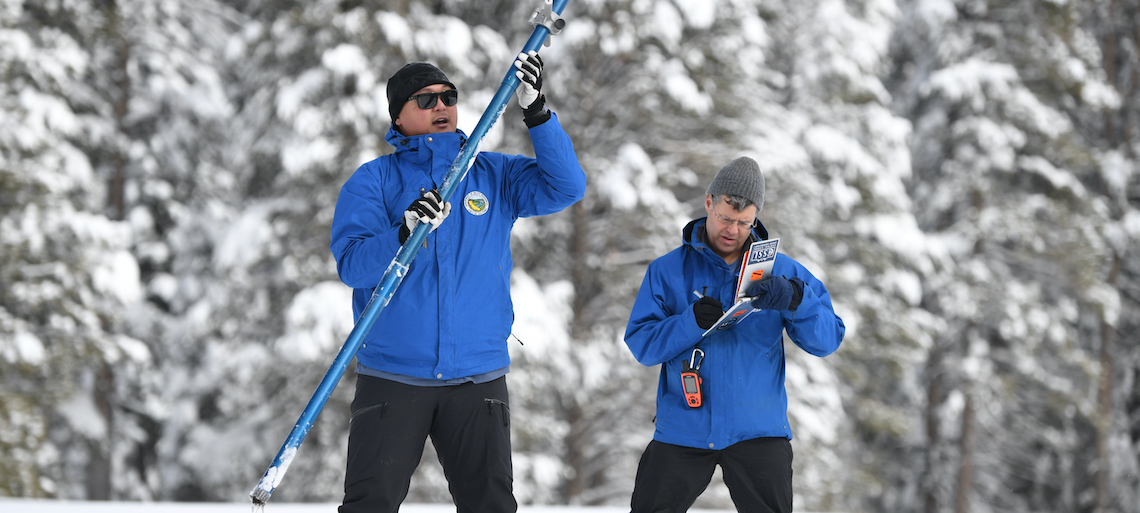
Sean de Guzman left, Chief of the California Department of Water Resources Snow Surveys and Water Supply Forecasting Section, and Andy Reising, right, Water Resources Engineer in the Snow Surveys and Water Supply Forecasting Unit, work the measurement phase of the first media snow survey of the 2023 season at Phillips Station in the Sierra Nevada Mountains. Photo taken January 3, 2023 by Ken James / California Department of Water Resources
Written by
The verdict for the litany of storms that have hit California over the last couple of weeks? A snowpack that is 174% of average for this time of year.
That’s the result of the year’s first snow survey conducted by the California Department of Water Resources on Tuesday.
State water officials take electronic readings from 130 stations throughout the state. Measurements indicate that the statewide snow water equivalent is 17.1 inches. This January’s results are similar to results in 2013 and 2022 when the Jan. 1 snowpack was at or above average conditions, only for dry weather to set in and lead to drought conditions by the end of the water year (Sept. 30), according to a news release from the state.
In 2013, the first snow survey of the season also provided promising results after a wet December. However, the following January and February were exceptionally dry, and the water year ended as the driest on record, contributing to a record-breaking drought. In 2022, record-breaking December snowfall was again followed by the driest first quarter on record.
California is expected to see continued rain and snow over the next seven days, with the threat of flooding in parts of California.
“The significant Sierra snowpack is good news but unfortunately these same storms are bringing flooding to parts of California,” said DWR Director Karla Nemeth. “This is a prime example of the threat of extreme flooding during a prolonged drought as California experiences more swings between wet and dry periods brought on by our changing climate.”
“Big snow totals are always welcome, but we still have a long way to go before the critical April 1 total,” said DWR’s Snow Surveys and Water Supply Forecasting Unit Manager Sean de Guzman. “It’s always great to be above average this early in the season, but we must be resilient and remember what happened last year. If January through March of 2023 turn out to be similar to last year, we would still end the water year in severe drought with only half of an average year’s snowpack.”
On average, the Sierra snowpack supplies about 30% of California’s water needs and is an important factor in determining how state water officials manage water resources.
Due to these increasing swings from dramatically wet to dry conditions, Gov. Newsom’s recently released “California’s Water Supply Strategy, Adapting to a Hotter, Drier Future” calls for investing in new projects and technologies that will modernize how the state manages water. In alignment with the Administration’s strategy, the recently adopted 2022 Update to the Central Valley Flood Protection Plan identifies actions needed to adapt much of California’s flood infrastructure to a rapidly changing climate. Current climate research indicates the state will see bigger swings from extreme heat and dry conditions to larger and more powerful storms that deliver temporary large boosts to the state snowpack as well as flood risk, according to the release.
Californians are encouraged to visit SaveOurWater.com for water saving tips and information, and to continue to conserve California’s most precious resource, rain or shine, according to the release.
The state conducts five media-oriented snow surveys at Phillips Station near Lake Tahoe each winter near the first of each month, January through April and, if necessary, May. The next survey is tentatively scheduled for Feb. 1.







